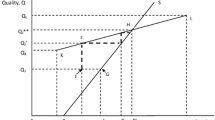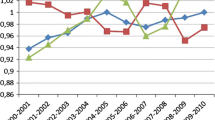Abstract
In The Netherlands the care for the disabled accounts for 10% of total health care costs, or almost 1% of GNP. About half of these costs are devoted to the residential care for the mentally disabled. This study studied the amount of cost inefficiency in a sample of homes operating in 1998. We first apply a data envelopment analysis to our sample and then apply another stage-evaluating the nonradial slack of each input and the effects external factors have on them. After “correcting” for the external effects we find that technical and scale inefficiency disappears and cost efficiency increases by 6%. We attribute these findings with the strict regulation under which Dutch homes operate. Further, this approach can be applied to any service or market that faces governmental regulation.

Similar content being viewed by others
References
Dor A, Duffy S, Wong H (1997) Expense preference behavior and contract-management: evidence from U.S. hospitals. South Econ J 64:542–554
Eggink E, Blank JLT (2001) Efficiency of homes for the mentally disabled in The Netherlands. Social and Cultural Planning Office: The Hague
Ferrier G, Valdmanis V (1997) Rural hospital performance and its correlates. J Productivity Anal 7:63–80
Fried HO, Schmidt SS, Yaisawarng S (1999) Incorporating the operating environment into a nonparametric measure of technical efficiency. J Productivity Anal 12:249–267
Lovell CAK (2000) Measuring efficiency in the public sector. In: Blank JLT (ed) Public provision and performance: Contributions from efficiency and productivity measurement. North-Holland: The Hague
Ramsey J (1969) Test for specification errors in classical linear least square regression analysis. J R Stat Soc Ser B 31:350–371
Ramsey J (1970) Models, specification error and inference: a discussion of some problems in econometric methodology. Bull Oxford Inst Econ Stat 32:301–318
Spady RH, Friedlaender AF (1978) A hedonic cost functions for the regulated trucking industry. Bell J Econ 9:159–179
Torgersen A, Førsund F, Kittelsen S (1996) Slack-adjusted efficiency measures and ranking of efficient units. J Productivity Anal 7:379–398
Zellner A (1962) An efficient method of estimating seemingly unrelated regression and tests of aggregation bias. J Am Stat Asso 57:500–509
Conflict of interest:
No information supplied
Author information
Authors and Affiliations
Corresponding author
Appendix
Appendix
The mathematical formulation of the CRS technical efficiency model is:
where CRS=technical efficiency under constant returns to scale, x0=vector of resources of home 0, y=vector of services, yo=vector of services of home 0, z=vector of weights, and λ=scalar.
The mathematical formulation of the VRS technical efficiency model is:
where VRS=technical efficiency under variable returns to scale.
For Ramsey’s “reset” the regression equation specification error test is used to test for the linearity of the model (e.g., [6, 7]). Since we are dealing here with a simultaneous system of equations, we must modify the original approach of Ramsey. The reset is computed as follows. From the estimates we compute the predicted values of the dependent variable of each equation in the system. Now we form the auxiliary regression of the dependent variables of each equation on the independent variables and the additional variables given by the quadratics of the predicted values. We reestimate the auxiliary model by SUR and investigate whether there is been a significant improvement in likelihood by conducting a likelihood-ratio test. Since we have five equations and we consequently use five additional variables, the degrees of freedom in the χ2 equals five.
Rights and permissions
About this article
Cite this article
Blank, J.L.T., Valdmanis, V. A modified three-stage data envelopment analysis. Eur J Health Econ 6, 65–72 (2005). https://doi.org/10.1007/s10198-004-0260-3
Issue Date:
DOI: https://doi.org/10.1007/s10198-004-0260-3




